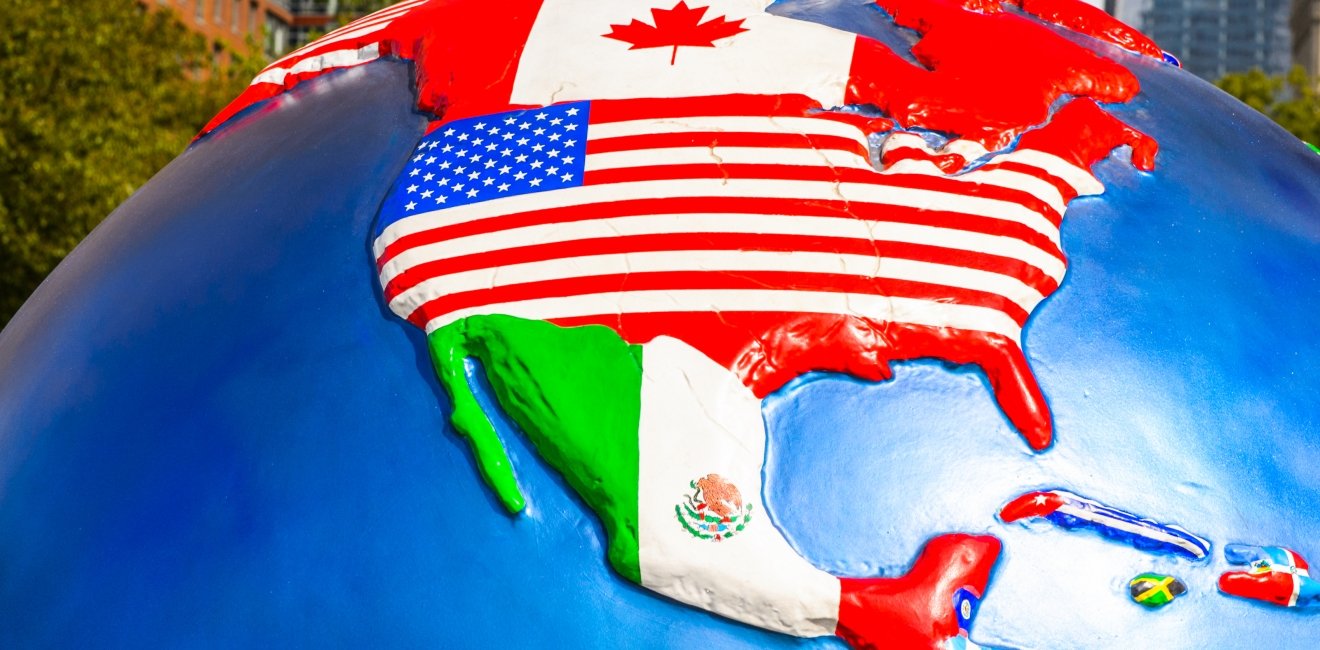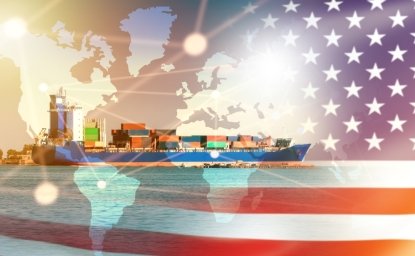The leaders of the U.S., Canada and Mexico have announced that they will meet in Washington on November 18. Such summits had not occurred during the previous U.S. administration and may give new impetus to efforts at cooperation across the North American continent. However, a somewhat less heralded but perhaps equally significant announcement was made in March of this year when two giant railroads, Canadian Pacific And Kansas City Southern revealed their plans for a merger. Because of Canadian Pacific’s extensive network in the United States and Kansas City Southern’s in Mexico, this means that once the deal is implemented goods will be able to travel on a single line from Edmonton, Alberta to Vera Cruz in southern Mexico. Although the merger has been highly publicized, the media has largely covered it as a business story, stressing its impact on railroad shareholders and shippers.[1]
What is remarkable, however, is how little the merger has been viewed in terms of broader North American integration, a subject of fierce debate in the 1990’s and 2000’s. At that time, after the creation of the North American Free Trade Agreement (NAFTA), the largely theoretical prospect of a “North American Super-highway” became a hot issue. It is largely forgotten now, although an old website promoting it can still be found on the internet.[2] After proponents had suggested investments in highway infrastructure along a north-south axis through the center of the United States linking Canada with Mexico, the idea was attacked as a vehicle for illegal drugs and immigration to pour in and a sign of tangible loss of American sovereignty. The Texas state legislature even went so far as to prohibit the construction of a “Trans-Texas corridor” as a portion of this route.[3]
So the mystery remains. Why is this very real railroad merger so uncontroversial while the proposed highway had been a focus for such intense objection? Does this mean that North American integration can now be viewed positively? Or does it mean that its prospects are so dim that a mere transportation development no longer excites any fears? Before looking at the future of the “North American idea”[4] as academic and government official Robert Pastor termed it, we should remember the turbulent history of efforts to bring the U.S., Canada, and Mexico closer together.
Through the nineteenth and into the early twentieth century North American integration was viewed in terms of the prospect of the United States annexing all or part of its northern and southern neighbors to fulfill its “manifest destiny.” Canada’s very confederation out of a series of existing British colonies was driven by fear of absorption into the United States as was the creation of the east-west Canadian Pacific railroad. Mexico has never forgotten that it lost vast stretches of land including what are now two of the U.S.’s largest states, California and Texas. Suspicion of the U.S. was eloquently expressed in Mexican President Porfirio Díaz’s famous (if apocryphal) remark: “Poor Mexico, so far from God and so close to the United States,”[5] and by Canadian Prime Minister Robert Borden’s election-winning 1911 campaign slogan: “No truck nor trade with the Yankees.”[6]
Of course, relations within North America ultimately proved far more positive than such slogans might indicate. The U.S. and Canada built a close alliance and developed a dense web of economic, cultural and human ties. U.S.-Mexico relations, though more difficult, also developed along peaceful, productive lines and Mexican immigration has had a major role in the U.S.’s becoming one of the world’s major homes of Spanish speakers and in building great cities such as Los Angeles, Phoenix and Houston.
The modern era of North America began with the creation of the U.S.-Canada Free Trade Agreement, which was negotiated under the leadership of President Reagan and Prime Minister Mulroney. Although generally supported in the U.S., it was loudly debated in Canada where traditional concerns about sovereignty, as well as left-wing distaste for Reagan administration policies were thoroughly aired. The North American Free Trade Agreement (NAFTA) incorporating Mexico was negotiated during the George H. W. Bush administration and ratified early in the Clinton administration.
The immediate post-NAFTA environment was marked by different impulses. There was an effort to widen it by creating a Free Trade Area of the Americas. There were proponents of deepening it, that is, further intensifying integration among NAFTA members. And there were ever louder voices opposed to the existence, let alone the broadening or deepening of the continent-wide free trade area.
The Free Trade Area of the Americas, an initiative of the George W. Bush administration, sought to knit together NAFTA with other free trade agreements which had previously been negotiated—with Central America and the Dominican Republic as well as with Peru and Chile—and ultimately to bring in the Mercosur countries of Brazil, Argentina, Uruguay and Paraguay. The effort foundered in the face of lack of interest from Mercosur, which under Brazilian leadership saw itself as an alternative pole to a U.S.-led grouping.
Those arguing for deepening NAFTA, a position which found its most articulate advocate in Robert Pastor, envisioned a process not unlike the “ever closer union”[7] that the European Union’s basic documents contemplate. Its foundation would be NAFTA’s conversion from a free trade agreement into a full-scale customs union, with a common external tariff and considerable freedom of movement among the member states. This too ultimately went nowhere. Though promoted by Mexican President Vicente Fox, it was not adopted by American or Canadian leaders, who likely sensed that domestic support for deeper integration was lacking.
Nonetheless some degree of North American institution building went forward. Periodic North American Leaders Summits took place from 2005 to 2016 (none took place during the Trump administration) as did some cabinet level consultations. A private “North American Forum” was established at the Hoover Institution with participation by such luminaries as former U.S. Secretary of State George Shultz, former Mexican Finance Minister Pedro Aspe, and former Alberta Premier Peter Lougheed.[8] Among the three governments the “Security and Prosperity Partnership of North America” was established which sought cooperation in practical areas such as regulatory harmonization, while steering clear of issues of greater political sensitivity.[9]
But even as NAFTA moved from negotiation to ratification a movement against continental integration began. Ross Perot made it a theme in the 1992 Presidential campaign, warning of the “great sucking sound” of jobs heading southward.[10] And indeed the loss of traditional industrial jobs had become a real issue in the U.S. (and to some degree Canada), and many were not impressed by response that technological change and increased trade with Asia were far more important factors and that free trade within North America could in fact anchor jobs in the U.S. A paranoid version of these concerns included assertions that the three countries would be merged into a single super-state with its own currency (the “amero,” a name taken from the European Union’s euro).[11]
Sentiment against further North American integration, of course, was integral to Donald Trump’s campaign which called for an end to NAFTA (“the worst trade deal maybe ever”)[12] and the construction of a wall to stop illegal immigration from Mexico. Ultimately reality imposed itself and NAFTA was re-negotiated into the U.S.-Mexico-Canada Agreement. While the changes were more than cosmetic (particularly as regards the auto industry, where tighter rules of origin for inputs arising from other countries were imposed), the heart of the three-way agreement was maintained, proving that regional trade integration was truly an egg that could not be unscrambled. And the much ballyhooed wall project, never a realistic solution to illegal immigration, proved to be financially, technically and politically unsustainable.
So where are we now? The Biden administration, naturally preoccupied with the coronavirus pandemic and the attendant economic crisis, has yet to lay out a broad trade agenda much beyond enforcement, particularly in the labor and environmental areas. Canada seems to have reverted to its historical focus on the bilateral relationship with the U.S., with little attention to the continent as a whole. And Mexico’s leftist President Andrés Manuel López Obrador has sounded traditional themes of sovereignty, particularly in the energy sector where he seeks to reverse his predecessors’ opening to foreign investment.
And the broader international environment has changed. The thrust towards North American integration came at a time when it appeared that the world was consolidating into regional blocs. The European Union, having both expanded eastward after the end of Soviet domination of Central Europe and deepened its own integration with the Maastricht Treaty, was seen as a strong competitor to and potential model for the United States. China’s explosive growth raised fears that it would bring much of Asia into its orbit. However, after Brexit and amidst tensions between the original EU members and newer, eastern ones, Europe’s prospects are less clear. And China is drawing ever greater suspicion from its neighbors. Although issues of global competition remain salient, one hears far less about the need for the U.S. to mount its own regional bloc than ten or twenty years ago.
Of course, a strong case for greater North American integration can still be made. The argument that removing barriers to trade allows firms (and countries) to pursue their comparative advantage and increase overall efficiency is as valid as it was when Adam Smith and David Ricardo were laying the foundations of modern economics. The survival of NAFTA, albeit with a few modifications and a new name, may show that this truth has been absorbed by the business and political leadership of all three countries. The question remains, however, as to whether North American integration on a more ambitious scale can be made convincing to their publics.
We are unlikely to see grand, highly publicized efforts at the political level to sell North America as an organizing principle for cooperation. For the near future at least, leaders are not likely to to provoke the mixture of paranoia, misinformation and genuine, if exaggerated fears that the concept has stirred up in the past. And the to the extent that the Biden administration takes a more internationally minded view than its predecessor it seemingly prefers to paint on a global rather than a regional canvas as shown by virtual summits on COVID and climate change.
Nonetheless there are areas in which North American integration will continue to make sense, even if it takes place under the political and media radar. The Canadian Pacific-Kansas City Southern merger shows that business sees opportunities. Other infrastructure projects likely will make sense too. For instance, America’s Pacific coast ports are overcrowded, a situation aggravated by pent-up demand for goods as its economy recovers. Expanded facilities, be they in Prince Rupert in British Columbia or Ensenada in Baja California could ease the strain.
As the pandemic has demonstrated, vulnerability to breakdowns in the provision of medical supplies from Asia has led to interest in “near-shoring” production. Canada is looking at reviving its attenuated vaccine production capability.[13] Mexico, already a producer of personal protective equipment,[14] may look to expand. There may be room for the three countries to coordinate their efforts in this sector. And concerns regarding China have by no means disappeared. Even as committed a nationalist as Mexico’s López Obrador has suggested that further integration with the United States may be required (though always respecting Mexico’s sovereignty) to keep China from completely dominating international trade.[15]
And beyond trade narrowly conceived, there are many areas where increased cooperation among the three nations may make sense. The “North America 2.0” project of the Woodrow Wilson Center, together with the Harvard Kennedy School’s Belfer Center and other partners, is engaging recognized experts to look at promising subjects. Analyses have already been produced on cooperation on North American border security as well as in the cyber and military areas. Studies have also been produced on trilateral cooperation on higher education, workforce development and migration. More will follow over the next year.[16]
While much of regional integration may take place among businesses, universities, NGOs and other non-state actors, there is room for the three governments to promote it as well. Some trilateral activities which had previously languished have been revived. The North American Leaders Summits, which were held during the administrations of Presidents Bush and Obama, are now being resumed, which will give high level attention to possibilities for deepening government-to-government interaction as well as providing a spur for further cooperation at the state/provincial level and by business, labor and non-governmental organizations.
Indeed, issues such as climate change (and with it the coming energy transformation) and public health, as we look beyond the current pandemic, all have trans-border elements which cry out for cooperation among these three neighboring countries, including governments, private sector actors and advocacy groups, even as global solutions are sought.
How far can the North American idea progress? We won’t see the much feared single North American super-state (or even the super-highway). We are also unlikely to see a European Union-style political bloc or customs union any time soon. But there are many areas in which practical cooperation may make sense. Perhaps the sound of the whistle as the freight trains roar south across borders and back north again may serve as inspiration.
[1] Uria, Daniel. “Canadian Pacific Railway acquires Kansas City Southern for 29B.” UPI. March 21, 2021. https://www.upi.com/Top_News/World-News/2021/03/21/US-Canada-Mexico-Pacifici-Railway-Canada-acquires-Kansas-City-Southern-29-billion/2191616349979/
[2] ”North America’s SuperCorridor Coalition, Inc.” Wayback Machine. https://web.archive.org/web/20060618072525/http://www.nascocorridor.com/
[3] ”Texas Legislature Online - 82(R) History for HB 1201.” https://capitol.texas.gov/BillLookup/History.aspx?LegSess=82R&Bill=HB1201
[4] Pastor, Robert A. “The North American Idea: A Vision of A Continental Future.” Oxford University Press. 2011.
[5] Libquotes. Porfirio Díaz. https://libquotes.com/porfirio-diaz/quote/lbj9p6x
[6] Marsh, James H. (ed.). “Canada and the United States.” The Canadian Encyclopedia. 2010. https://thecanadianencyclopedia.ca/en/article/canada-and-the-united-states
[7] Miller, Vaughne. “Briefing Paper: ‘Ever Closer Union’ in EU Treaties and Court of Justice case law.” House of Commons Library. November 16, 2015. https://researchbriefings.files.parliament.uk/documents/CBP-7230/CBP-7230.pdf
[8] “North American Forum.” Hoover Institution. https://www.hoover.org/about-north-american-forum
[9] ”Security and Prosperity Partnership of North America.” Archives. U.S. Department of State. https://2001-2009.state.gov/p/wha/rt/spp/index.htm
[10] Jelen, Ted G. (ed.). “Ross for Boss: The Perot Phenomenon and Beyond.” SUNY Press. 2001.
[11] Bennett, Drake. “The Amero Conspiracy.” New York Times. November 25, 2007. https://www.nytimes.com/2007/11/25/world/americas/25iht-25Amero.8473833.html
[12] Severns, Maggie. “Trump pins NAFTA, ‘worst trade deal ever,’ on Clinton.” Politico. September 26, 2016. https://www.politico.com/story/2016/09/trump-clinton-come-out-swinging-over-nafta-228712
[13] Trumbull, Sarah. “Feds commit nearly $200M to be able to mass produce RNA vaccine in Canada.” CTV News. May 19, 2021. https://www.ctvnews.ca/health/coronavirus/feds-commit-nearly-200m-to-be-able-to-mass-produce-mrna-vaccine-in-canada-1.5432808
[14] Sieff, Kevin. “Mexican factories boost production of medical supplies for U.S. hospitals while country struggles with its own coronavirus outbreak.” Washington Post. April 3, 2020. https://www.washingtonpost.com/world/the_americas/mexican-medical-manufacturers-boost-production-for-us-hospitals-while-country-struggles-with-its-own-coronavirus-outbreak/2020/04/03/0e624fea-7517-11ea-ad9b-254ec99993bc_story.html
[15] “Discurso del Presidente Andrés Manuel López Obrador en el 238 aniversario del natalicio de Simón Bolívar en el Palacio de Chapultepec.” July 24, 2021. https://lopezobrador.org.mx/2021/07/24/discurso-del-presidente-andres-manuel-lopez-obrador-en-el-238-aniversario-del-natalicio-de-simon-bolivar-desde-el-castillo-de-chapultepec/
[16] ”North America 2.0: Forging a Continental Future.” Woodrow Wilson International Center for Scholars. May 18, 2021. https://www.wilsoncenter.org/article/north-america-20-forging-continental-future







